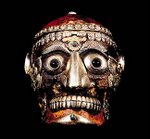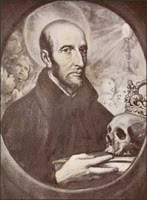The first legal 'modern' cremation in the United States of America, occuring on 6th December 1876, was that of a rather colourful character called Baron de Palm. He had originally emigrated from Bavaria and, from what I can gather, was an enthusiastic member of the Theosophical Society. This movement espoused a number of 'exotic' ideas and practices, especially those which found their provenance in eastern religions, including cremation. At the time of the Baron's death the cremation movement was burgeoning in the USA, just as it was here in Britain. In "Purified By Fire: A History of Cremation in America" 2001, Stephen Prothero gives a detailed analysis of the many social, scientific and religious arguments which were put forward concerning the disposal of the dead. It seems that the cremation debate was high on the agenda for many Americans of the "gilded age" and that the cremationists sought a practical demonstration of cremation, in order for there to be an informed judgement concerning its merits. This was to arrive in the form of the dessicated corpse of Baron De Palm. Believing in the value of cremation in improving public health and hygiene, a certain philanthropist named Dr Francis Julius Lemoyne designed and built a crematorium on his own land in Washington Pennsylvania and had been looking for a suitable opportunity to test it. Baron De Palm's body had been mummified over a year before and it was agreed by the custodians of his corpse in the Theosophical Society that it should undergo a modern cremation in America at some future point. Prothero describes the eventual scene of its incineration, which he has reconstructed from historical records. It was, by all accounts, a major news event, covered in all the major American newspapers. Crowds of reporters and curious onlookers, vying to observe the macabre spectacle which was unfolding before them, created what can only be described as a carnival atmosphere on that bleak winter's morning.

Dr Lemoyne and his retort
Prothero vividly describes the ensuing scene in "Purified By Fire" ps33-34:
"After Mr. Wolfe, the fireman who had started feeding the furnace with coke at two o'clock in the morning, declared the machinery ready, the guests took one last look at the body. Someone pulled the sheet down a bit, exposing a face with a horribly pained countenance. After this final, grotesque viewing, Olcott, LeMoyne, and two other men appointed to usher the body into the furnace took off their hats, as if to signal that whatever reverence might be mustered should be expended forthwith. Members of the impromptu congregation dutifully removed their bowlers. Then the body was lifted and "solemnly borne" across the threshold of the two-room crematory into the furnace room, and cremation's rite of passage to America was underway. Olcott, in his capacity as high priest, soaked the white sheet covering the corpse with water saturated in alum in an effort to prevent both the body's immediate blazing and any further public display of the baron's nakedness. In a nod to the Asian origins of cremation and the Theosophist's love of Mother India, someone placed a simple clay urn--"the present of a friend in the East"--atop the furnace. Olcott then sprinkled the body with spices, including cassia, cinnamon, cloves, frankincense, and myrrh. According to one confused reporter, the Theosophist was "following the Egyptian ceremonials, with a touch of the Indian, Greek and Roman customs." But he was also bequeathing to the occasion a vaguely Christian air--playing the Wise Man bringing spices from the East. Finally, Olcott placed on the corpse a collection of roses, smilax, primroses, and palms, as well as evergreens as a symbol, he announced, of the immortality of the soul. Recalling perhaps the Christian tradition of burying lay people with their heads to the west so they could look to the east for the Second Coming, Olcott and LeMoyne debated whether it was more auspicious to place the body into the furnace head-first or feet-first. The fireman and the crematory's builder then joined the procession, forming a coterie of six pallbearers, as in a traditional burial. At approximately 8:30 A.M. they slid the baron's body into the retort head-first.
There was a momentary sizzle and a bit of smoke. But soon the door was cemented shut and the furnace made airtight. The evergreens and the hair around the head caught on fire, and "the flames formed," according to the Times reporter, "a crown of glory for the dead man." At first witnesses were repelled by the smell of burning flesh, but soon the sweeter aromas of flowers and spices banished foul odors from the room. Witnesses who peered through a peephole in the side of the furnace noted that the flowers were almost miraculously reduced to ash without losing their "individual forms." About an hour into the proceedings a rose-colored mist enveloped the body. Later the mist turned to gold. Meanwhile, the corpse became red-hot and then transparent and luminous. All these effects lent to the retort "the appearance of a radient [sic] solar disk of a very warm. . . color." After some time yet another intimation of immortality pressed itself on the witnesses: "the palm boughs. . . stood up as naturally as though they were living portions of a tree." Then the left hand of the baron rose up and three of his fingers pointed skyward. The scientists present later attributed this incident to involuntary muscular contractions, but others saw in it something of a spiritual phenomenon. The main event concluded officially at 11:12 A.M., when Dr. Folsom, secretary of the Massachusetts Board of Health, formally pronounced the incineration complete. All that remained of the body had fallen lifelessly to the bottom of the retort, but the ashes of a few sprigs of evergreen remained, seemingly suspended in air above the iron cradle. Cremationists interpreted this too as a propitious sign."

Now that is what I call a story. I did say in a recent posting that I'd try to steer away from thanatological matters but then Prothero's book is an excellent one and this is a tale which, in my view, is of some historical significance and interest.
Bone Idle

 The Devraha Baba shortly before his 1989 demise at the age of 250.
The Devraha Baba shortly before his 1989 demise at the age of 250.









 This article in the Times put me in mind of a book I read recently - a rather sobering book entitled "Last Rites: The End of the Church of England" (2006) by Michael Hampson, a somewhat jaded ex-clergyman. He makes the case quite convincingly that the Church of England, riven as it is by the seemingly intractible in-fighting between evangelicals and liberals, severely wounded by the fall-out over the ordination of women and deeply divided on the issue of homosexual clergy, has become increasingly marginalised and irrelevant to mainstream contemporary British society and is, because of these factors, in a state of irreversible and terminal decline. Overall, Hampson posits the view that the CofE has had its day and must reform itself and`downsize' quite considerably if it is to survive at all. It will certainly cease to be the Church of the Nation so perhaps today's news should come as no surprise. It is simply another nail in the Anglican coffin, confirming the inevitable.
This article in the Times put me in mind of a book I read recently - a rather sobering book entitled "Last Rites: The End of the Church of England" (2006) by Michael Hampson, a somewhat jaded ex-clergyman. He makes the case quite convincingly that the Church of England, riven as it is by the seemingly intractible in-fighting between evangelicals and liberals, severely wounded by the fall-out over the ordination of women and deeply divided on the issue of homosexual clergy, has become increasingly marginalised and irrelevant to mainstream contemporary British society and is, because of these factors, in a state of irreversible and terminal decline. Overall, Hampson posits the view that the CofE has had its day and must reform itself and`downsize' quite considerably if it is to survive at all. It will certainly cease to be the Church of the Nation so perhaps today's news should come as no surprise. It is simply another nail in the Anglican coffin, confirming the inevitable. 



















